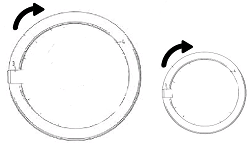11. Time Zone Differences and Probability, Ratios and Speed
TIME ZONE DIFFERENCES
The exam may require you to calculate the difference between times or what the real time is. To calculate you must be clear on:
- Base time
- Comparison time.
- Convert 1 to another usually by addition (going up) or subtraction (going down). Remember that there are 12 hours per clock AM time and 12 hours per PM time.
Let's demonstrate with this example:
Tokyo is 16:0 hours ahead of Vancouver _.__
What time it is it in Tokyo if it is 1:00am in Vancouver?_
My wristwatch is 3 hours behind the school clock and my home clock is 2 hours behind my wristwatch. If the school clock rings at 3pm and I get home 1 hour after that; what time would my home clock show when I arrive at home?
RATIOS
Ratios are used to compare multiple amounts of quantities to each other. Common examples are:
- Flour to water
- Gears in a bicycle
- How many girls compared to boys in a class
Things to remember with ratios:
- PART A : PART B or Part A to Part B
- PART A + PART B = TOTAL
- 5:15
- Total number 20.
- 2:4:6
- Total number 12.
- You can even simplify if sharing common factors:
- 2:4:6
- 1:2:3
PROBABILITY
Probability means the likelihood of something happening. For example:
- Warm weather
- Parents being upset
- Getting a pass.
- Probability of an insurance claim being made.
- Impossible = 0; Certainty = 1
Probability of an event happening = Number of ways it can happen / Total number of outcomes.
Let's look at a die rolling once for a 6.
Let's also look at 2 dice rolling to get a 4.
SPEED
Formula to calculate is SPEED = DISTANCE / TIME.
Remember there are 3 components and easiest way to think about it is the speedometer.
Example, speedometer says you're travelling at 5km/hour, 50km/hour
Example Question 1
Jess drives at an average speed of 60 km/h from Sydney to Orange which is approximately 360km. How long does she take?
Example Question 2
Anders cycles at an average speed of 5m/h. If he cycles for 3 hours how far has he gone?
Now let's do some practice questions:
Q 28 - What is the speed in m/s of a bicycle that travels 9 km in 25 minutes?
A 3 m/s B 6 m/s C 9 m/s D 12 m/s E None of these
Q14 - Questions 14 – 15 refer to the following information:
Jake has two rotating wheels.

When the larger wheel turns 15 times the smaller wheel turns 60 times. Assuming that their rotating speed are the same, what is the circumference of the larger wheel if the smaller wheel has a circumference of 62 cm?
A 186 cm B 248 cm C 630 cm D 992 cm
Q 15 - If you let the larger wheel roll on the ground, how far will it travel if it turns 50 times?
A 48 metres B 72 metres C 96 metres D 124 metres
Now let's recap.
Now it's time to do your assignment.
- Download the assignment question here.
- Print it out or if you want to do it electronically, save it.
- Complete the questions to it.
- Then check the solutions on the video below or download the ANSWER KEY here.